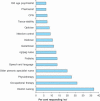Geriatricians and care homes: perspectives from geriatric medicine departments and primary care trusts
- PMID: 20095292
- PMCID: PMC4952288
- DOI: 10.7861/clinmedicine.9-6-528
Geriatricians and care homes: perspectives from geriatric medicine departments and primary care trusts
Abstract
Older people in care homes are clinically complex and particularly vulnerable to the effects of poor care and poor medicine. They are also a group to whom the NHS seems least committed. Geriatricians have become disengaged over the past two decades, as a result of social policies rather than clinical judgements. In 2000, the Royal College of Physicians, with the Royal College of Nursing and the British Geriatrics Society, issued guidance and recommendations for improving clinical practice. This paper reports progress since then based on results of national surveys of geriatric medicine departments and primary care trusts in England. The results show that important deficiencies persist, though most respondents were in favour of greater specialist involvement. Some suggestions are made for ways to improve the shared care of residents in care homes.
Figures







References
-
- Commission for Social Care Inspection. The state of social care in England 2006–07. London: CSCI, 2008. www.csci.org.uk/professional/about_csci/publications/view.aspx?csci=2349
-
- Department of Health. Continuing care: NHS and local councils’ responsibilities. London: DH, 2001. www.dh.gov.uk/en/Publicationsandstatistics/Lettersandcirculars/LocalAuth....
-
- Department of Health. The National Framework for NHS continuing healthcare and NHS-funded nursing care. London: DH, 2007. www.dh.gov.uk/en/Publicationsandstatistics/Publications/PublicationsPoli....
-
- Royal College of Physicians. The health and care of older people in care homes: report of a joint working party of the Royal College of Physicians, the Royal College of Nursing and the British Geriatrics Society. London: RCP, 2000.
-
- British Geriatrics Society. Specialist medical input to residential and nursing home resident. London: BGS, 2004.
Publication types
MeSH terms
LinkOut - more resources
Full Text Sources
Miscellaneous

